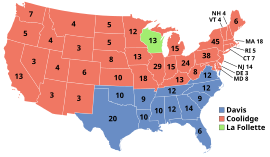Presidential election in the United States in 1924
| ‹ 1920 • |
|||||||||||
| 35th presidential election | |||||||||||
| November 4, 1924 | |||||||||||
|
|
|||||||||||
| Republican Party | |||||||||||
| Calvin Coolidge / Charles Dawes | |||||||||||
| electors | 382 | ||||||||||
| be right | 15,723,789 | ||||||||||
|
|
54.0% | ||||||||||
| Democratic Party | |||||||||||
| John W. Davis / Charles Bryan | |||||||||||
| electors | 136 | ||||||||||
| be right | 8,386,242 | ||||||||||
|
|
28.8% | ||||||||||
| Progressive party | |||||||||||
| Robert La Follette / Burton Wheeler | |||||||||||
| electors | 13 | ||||||||||
| be right | 4,831,706 | ||||||||||
|
|
16.6% | ||||||||||
|
|
|||||||||||
| Election results by state | |||||||||||

|
|||||||||||
|
35 states of
Coolidge / Dawes |
12 states
Davis / Bryan |
||||||||||
|
1 State of
La Follette / Wheeler |
|||||||||||
|
|
|||||||||||
| President of the United States | |||||||||||
In the US presidential election of 1924 , the Republican Calvin Coolidge , who had assumed office since the death of Warren G. Harding in 1923, and Charles G. Dawes ran as a candidate for the vice presidency . They stood for a continuation of their economic policy, which was based on the laissez-faire theory and caused an economic boom in their first term of office. On the foreign policy front, Coolidge and Dawes continued to advocate the isolationism introduced by Harding as a turnaround to Wilsonianism . As in the 1920 presidential election , conservative celebrities from Hollywood supported the Republicans, including singer Al Jolson . It was the first election campaign in the world whose main stations were broadcast by the then new medium of radio .
For the Democrats as candidates John W. Davis , a nationally virtually unknown former Congressman from West Virginia , and as his running mate Charles W. Bryan , the governor of Nebraska . They stood for Woodrow Wilson's policies , in which the state increased taxes and regulated the economy more. In terms of foreign policy, they called for greater US involvement and entry into the League of Nations . Davis was a compromise candidate who was first nominated after the two original favorite, former Treasury Secretary William Gibbs McAdoo and Governor Al Smith of New York on a Brokered Convention in more than 100 ballots were against each other.
Despite the split of the Progressives under Robert M. La Follette , who could only win his home state Wisconsin , Calvin Coolidge managed a high victory. Under his leadership, the US achieved high economic growth and considerable population prosperity. There was also a boom in stocks, with more and more Americans speculating successfully on the stock market .
Result

| candidate | Political party | be right | electors | |
|---|---|---|---|---|
| number | percent | |||
| Calvin Coolidge | republican | 15,723,789 | 54.0% | 382 |
| John W. Davis | democrat | 8,386,242 | 28.8% | 136 |
| Robert M. La Follette | Progressive | 4,831,706 | 16.6% | 13 |
| Herman P. Faris | Prohibitionist | 55,951 | 0.2% | 0 |
| William Z. Foster | Communist | 38,669 | 0.1% | 0 |
| Other | 60,750 | 0.2% | 0 | |
| total | 29.097.107 | 100% | 531 | |
266 votes were necessary for the election to the president.
literature
- Donald Richard Deskins, Hanes Walton, Sherman C. Puckett: Presidential Elections, 1789-2008: County, State, and National Mapping of Election Data. University of Michigan, Ann Arbor 2010, ISBN 978-0-472-11697-3 , pp. 327-336 (= Chapter 37: Calvin Coolidge's Election. ).
Web links
Individual evidence
- ↑ Der deutsche Rundfunk , issue 31 of August 3, 1924, p. 1718
- ^ Lynda Lee Kaid & Mary Christine Banwart: Election Coverage . In Christopher H. Sterling & Cary O'Dell (Eds.): The Concise Encyclopedia of American Radio . Routledge, New York City 2010, ISBN 0-415-99533-7 , p. 258 .


